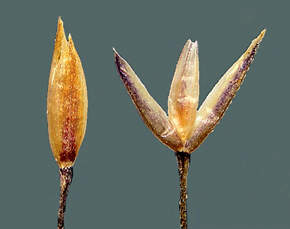
RODRIGO RODRIGUESInflorescence (top) and spikelets of Agrostis lenis: grass rediscovered in the state of São Paulo after 89 yearsRODRIGO RODRIGUES
Walking in the woods amid trees and bushes, few people look very closely at the ground. A group at the Botanical Institute of São Paulo, led by Tarciso Filgueiras, has made new discoveries doing exactly that. The work of Filgueiras, Rodrigo Rodrigues, and Regina Shirasuna is to investigate gramineous species (grasses) in the state of São Paulo, for studies such as the surveys conducted for construction of the Mario Covas Beltway. Their most recent finding is Agrostis lenis, a grass once considered extinct in the state of São Paulo (the most recent specimen had been collected 89 years ago) and now discovered again at Serra da Bocaina National Park, near the border with the states of Rio de Janeiro and Minas Gerais (Check List, January 2015). “It is a small, slender, annual grass, which makes it difficult to collect and identify,” explains Rodrigues. It can only be identified through an analysis of the flowers – minuscule structures, grouped by the hundreds in yellowish clusters. Few have the patience for it, not to mention the need to be present during the species’ flowering season, between summer and autumn. The supposed extinction of A. lenis applied only to the mountains of São Paulo: there are historical records of the grass being found in other areas of the Mantiqueira Mountains. In recent years, its presence was reported in the southern region of Brazil (where it is most common) and in the states of Rio de Janeiro and Minas Gerais, always in mountainous regions. Starting in 2009, the group also rediscovered other species and included São Paulo in the distribution range of grasses that had previously not been listed for the state. In light of the group’s findings, Rodrigues emphasizes “the importance of knowing [the existing] biodiversity, for effective conservation and the potential sustainable use of these areas and the species that they contain.”
Republish
